

The 1122 measures AC current up to 30 Amps and DC Current from -30Amps to +30Amps. Dual outputs allow the user to measure both the AC and DC components of complex current waveforms separately.
This sensor can be read by any Phidget with an Analog Input or VINT Hub port. It will connect to either one using the included Phidget cable. VINT Hub ports can behave just like Analog Inputs, but have the added flexibility of being able to be used as digital inputs, digital outputs, or ports to communicate with VINT devices. For more information about VINT, see the VINT Overview page.
| Product | Voltage Inputs | ||
|---|---|---|---|
| Part Number | Price | Number of Voltage Inputs | Voltage Input Resolution (bits) |
 VINT Hub Phidget
|
$40.00 | 6 (Shared) | *** 15 bit |
 1-Port VINT Hub Phidget
|
$24.00 | 1 (Shared) | ** 16 bit |
 VINT Hub Phidget
|
$35.00 | 6 (Shared) | * 15 bit |
 VINT Hub Phidget
|
$30.00 | 6 (Shared) | *** 15 bit |
 Wireless VINT Hub
|
$60.00 | 6 (Shared) | * 16 bit |
 PhidgetSBC4
|
$120.00 | 6 (Shared) | * 16 bit |
 PhidgetInterfaceKit 8/8/8
|
$80.00 | 8 | — |
 PhidgetInterfaceKit 2/2/2
|
$50.00 | 2 | 10 bit |
 8x Voltage Input Phidget
|
$20.00 | 8 | 12 bit |
 PhidgetInterfaceKit 8/8/8
|
$80.00 | 8 | 10 bit |
 PhidgetInterfaceKit 8/8/8 Mini-Format
|
$70.00 | 8 | 10 bit |
 PhidgetInterfaceKit 8/8/8 w/6 Port Hub
|
$110.00 | 8 | 10 bit |
 PhidgetTextLCD 20X2 : White : Integrated PhidgetInterfaceKit 8/8/8
|
$70.00 | 8 | 10 bit |
This sensor comes with its own Phidget cable to connect it to an InterfaceKit or Hub, but if you need extras we have a full list down below. You can solder multiple cables together in order to make even longer Phidget cables, but you should be aware of the effects of having long wires in your system.
| Product | Physical Properties | |
|---|---|---|
| Part Number | Price | Cable Length |
 Phidget Cable 10cm
|
$1.50 | 100 mm |
 Phidget Cable 30cm
|
$1.75 | 300 mm |
 Phidget Cable 60cm
|
$2.00 | 600 mm |
 Phidget Cable 60cm
|
$2.00 | 600 mm |
 Phidget Cable 90cm
|
$2.00 | 900 mm |
 Phidget Cable 120cm
|
$2.25 | 1.2 m |
 Phidget Cable 150cm
|
$2.50 | 1.5 m |
 Phidget Cable 180cm
|
$2.75 | 1.8 m |
 Phidget Cable 350cm
|
$3.00 | 3.5 m |
 Phidget Cable Kit
|
$10.00 | 80 mm |
 Phidget Cable Extension Wire 22AWG
|
$0.75/Meter | — |
Welcome to the 1122 user guide! In order to get started, make sure you have the following hardware on hand:
Next, you will need to connect the pieces:
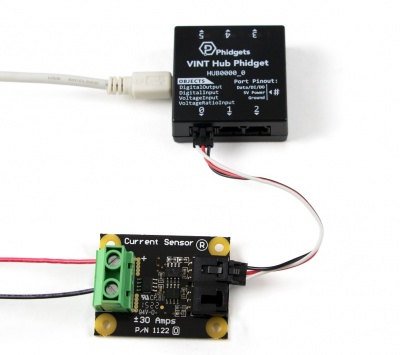
Now that you have everything together, let's start using the 1122!
In order to demonstrate the functionality of the 1122, we will connect it to the HUB0000, and then run an example using the Phidget Control Panel on a Windows machine.
The Phidget Control Panel is available for use on both macOS and Windows machines. If you would like to follow along, first take a look at the getting started guide for your operating system:
Linux users can follow the getting started with Linux guide and continue reading here for more information about the 1122.
After plugging in the 1122 into the HUB0000, and the HUB0000 into your computer, open the Phidget Control Panel. You will see something like this:
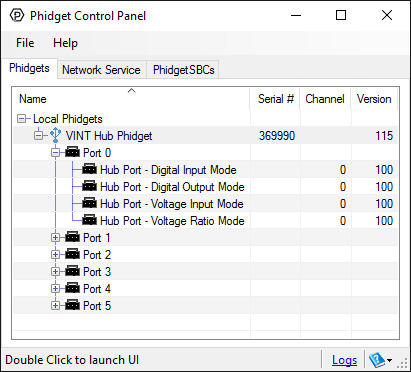
The Phidget Control Panel will list all connected Phidgets and associated objects, as well as the following information:
The Phidget Control Panel can also be used to test your device. Double-clicking on an object will open an example.
Double-click on a Voltage Ratio Input object in order to run the example:
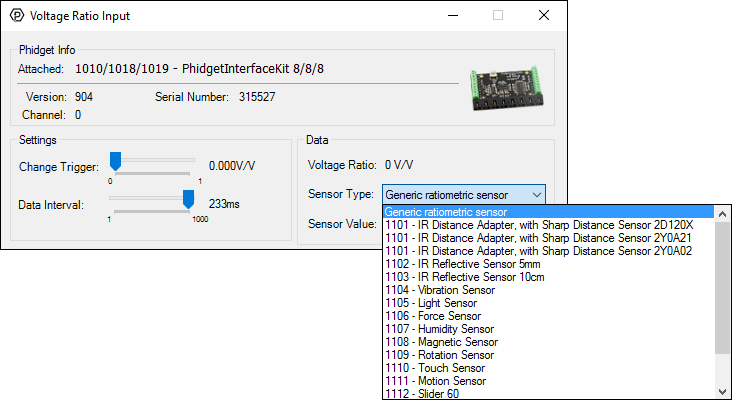
General information about the selected object will be displayed at the top of the window. You can also experiment with the following functionality:
The 1122 measures alternating current (AC) up to 30 Amps and direct current (DC) between –30 and +30 Amps. It uses a Hall effect based sensor to measure the magnetic field induced by the applied current flowing through a copper conductor. It then converts the magnetic data into a current measurement with internal calculations. The AC output will give the root mean square (RMS) value of an alternating current assuming the current is sinusoidal, and the sine wave is varying equally across the zero point. The AC output can also be used for signals that are not varying evenly around the zero point but the value will be the RMS plus a DC component. If a DC signal is being measured, the AC output will produce a signal that can be used to calculate the current but without the value representing direction of current flow.
The 1122 should be wired in series with the circuit under test, as shown in the following diagrams:
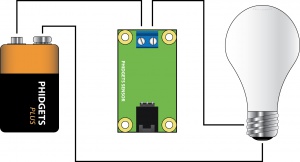
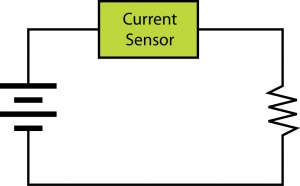
In the diagrams above, the voltage source is represented by the battery symbol. The load is represented by a light bulb or schematic resistor symbol. The current flowing from the battery to the load is measured through the current sensor.
The Phidget libraries can automatically convert sensor voltage into amperage (A) by selecting the appropriate SensorType. See the Phidget22 API for more details. The formula to translate voltage ratio from the sensor into amperage is:

The Phidget Cable is a 3-pin, 0.100 inch pitch locking connector. Pictured here is a plug with the connections labelled. The connectors are commonly available - refer to the Analog Input Primer for manufacturer part numbers.
| Sensor Properties | |
|---|---|
| Sensor Type | Current (AC/DC In-Line) |
| Controlled By | VoltageRatio Input |
| Sensor Output Type | Ratiometric |
| Input Current Min | ± 75 mA |
| Input Current Max | ± 30 A |
| Surge Current (Input) | 100 A |
| Measurement Error Max | 5 % |
| Sensor Response Time Max | 10 ms |
| Electrical Properties | |
| Input Frequency | 10 kHz |
| Supply Voltage Min | 4.5 V DC |
| Supply Voltage Max | 5.5 V DC |
| Current Consumption Max | 10 mA |
| Output Impedance | 1 kΩ |
| Input Impedance | 1.5 mΩ |
| Output Voltage Min | 0 V DC |
| Output Voltage Max | 5 V DC |
| Physical Properties | |
| Recommended Wire Size | 10 - 26 AWG |
| Operating Temperature Min | -40 °C |
| Operating Temperature Max | 85 °C |
| Customs Information | |
| Canadian HS Export Code | 8473.30.00 |
| American HTS Import Code | 8473.30.51.00 |
| Country of Origin | CN (China) |
| Date | Board Revision | Device Version | Comment |
|---|---|---|---|
| March 2008 | 0 | N/A | Product Release |
This device doesn't have an API of its own. It is controlled by opening a VoltageRatioInput channel on the Phidget that it's connected to. For a list of compatible Phidgets with VoltageRatio Inputs, see the Connection & Compatibility tab.
You can find details for the VoltageRatioInput API on the API tab for the Phidget that this sensor connects to.
| Product | Sensor Properties | |||||
|---|---|---|---|---|---|---|
| Part Number | Price | Sensor Type | Controlled By | Input Current Min | Input Current Max | Current Measurement Resolution |
 30A Current Sensor Phidget
|
$25.00 | Current (DC In-Line Hall Effect) | VINT | -30 A | 30 A | 1.1 mA |
 Clip-on Current Transducer 25A
|
$15.00 | Current (DC Clip-on) | Voltage Input (0-5V) | -25 A | 25 A | 10 mA |
 Clip-on Current Transducer 75A
|
$20.00 | Current (DC Clip-on) | Voltage Input (0-5V) | -75 A | 75 A | 10 mA |
 DC Current Sensor 0-10mA
|
$95.00 | Current (DC In-Line) | Voltage Input (0-5V) | 0 A | 10 mA | — |
 DC Current Transducer ±100A
|
$35.00 | Current (DC Through-Hole) | ±12V Adapter | -100 A | 100 A | 200 mA |
 DC Current Transducer ±250A
|
$35.00 | Current (DC Through-Hole) | ±12V Adapter | -250 A | 250 A | 500 mA |
 DC Current Transducer 0-100A
|
$35.00 | Current (DC Through-Hole) | ±12V Adapter | 0 A | 100 A | 100 mA |
 DC Current Transducer 0-250A
|
$35.00 | Current (DC Through-Hole) | ±12V Adapter | 0 A | 250 A | 250 mA |
 i-Snail AC Current Sensor 100Amp
|
$40.00 | Current (AC Through-Hole) | Voltage Input (0-5V) | 0 A | 100 A | 100 mA |
 i-Snail AC Current Sensor 10Amp
|
$40.00 | Current (AC Through-Hole) | Voltage Input (0-5V) | 0 A | 10 A | 10 mA |
 i-Snail AC Current Sensor 25Amp
|
$40.00 | Current (AC Through-Hole) | Voltage Input (0-5V) | 0 A | 25 A | 25 mA |
 i-Snail AC Current Sensor 50Amp
|
$40.00 | Current (AC Through-Hole) | Voltage Input (0-5V) | 0 A | 50 A | 50 mA |
 30 Amp Current Sensor AC/DC
|
$31.00 | Current (AC/DC In-Line) | VoltageRatio Input | ± 75 mA | ± 30 A | — |